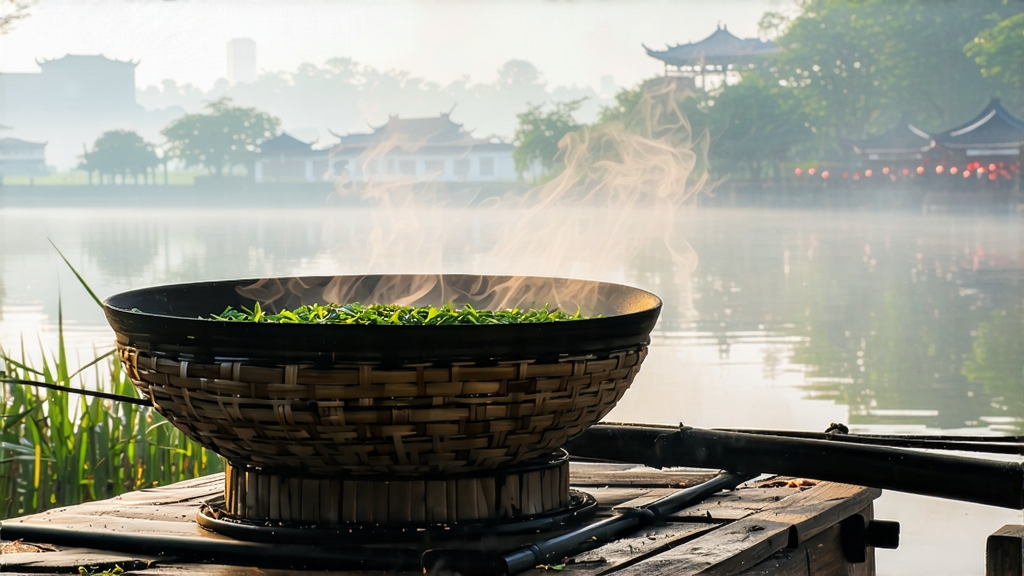
Longjing, literally “Dragon-Well,” is the most celebrated among China’s more than one thousand green-tea entries. To the Chinese palate it is the benchmark of elegance: a single sip can evoke morning mist over West Lake, the gentle clack of bamboo against silken buds, and the faint sweetness that lingers like a line of Tang poetry. To the rest of the world it is simply “that jade-green tea from Hangzhou,” yet behind the luminous liquor lies a millennium of dynastic favor, secretive gardens, and craftsmanship so precise that a five-second misjudgment in the wok can turn treasure into trash.
History: From Buddhist Legend to State Gift
The first credible record appears in the Northern Song (960-1127) when the monk Bian Cai at Longjing Village cured the local well of turbid water; grateful villagers planted tea bushes on the surrounding Lion Peak. By the Ming, the Hongwu Emperor exempted the monks from land tax in exchange for tribute tea, and the Qing’s Qianlong Emperor—so the story goes— personally pocketed a handful of buds while visiting the temple, later decreeing that the eighteen bushes he plucked from should become imperial property. Those bushes still survive, fenced but not caged, and every spring their yield is auctioned for more than the price of gold. In 1972 Premier Zhou Enlai served Longjing to President Nixon during the Shanghai Communiqué negotiations, sealing the tea’s role as liquid diplomacy.
Terroir: Why West Lake Matters
Chinese green teas are named after place before leaf style; remove Longjing from its cradle and it legally ceases to be Longjing. The West Lake micro-basin enjoys a frost-delaying lake effect, 1,600 mm annual rainfall, and quartz-rich sandstone soil that drains quickly yet holds warmth. The most coveted sub-zones—Shi (Lion), Long (Dragon), Yun (Cloud), Hu (Tiger), Mei (Plum)—sit between 150 and 300 m elevation, where morning fog refracts light into soft, diffuse beams ideal for amino-acid accumulation. The result is a leaf that is unusually low in astringent catechins yet high in theanine, gifting the tea its famous “four uniques”: jade color, vegetal aroma, mellow chestnut sweetness, and elegant flat shape.
Cultivars: Beyond the Iconic Eighteen
While the heirloom species is Camellia sinensis var. sinensis ‘Longjing Qunti,’ clonal selections have expanded the palette. Longjing #43, bred in 1972, sprouts seven to ten days earlier, yields a brighter green infusion, and tolerates machine harvesting, making up 60 % of commercial acreage. The traditional Qunti, however, still commands higher prices for its deeper, more complex bouquet reminiscent of fennel and white sesame. A third cultivar, Zhongcha 108, trades some fragrance for frost resistance and is planted on higher, cooler slopes. Purists insist that only Qunti grown within the 168 km² protected zone deserves the stamp “West Lake Longjing,” yet market dynamics push neighboring counties to mimic the style, creating the broader category “Zhejiang Longjing.”
Craft: The 10-Hand Motion in a 270 °C Wok
Within hours of picking, the fragile buds must be “killed-green” to halt oxidation. Longjing’s signature is not rolling but pressing, flattening, and smoothing in a bare iron wok that glows a dull cherry red. A master—always a master, never a machine—uses bare fingers to judge temperature by ear: the leaf should hiss like distant surf, never crackle. Ten distinct hand motions—抓 (grasp), 抖 (shake), 搭 (press), 拓 (spread), 捺 (push), 推 (slide), 扣 (snap), 甩 (flick), 磨 (grind), 压 (compress)—are executed in cycles lasting 25–30 minutes. Moisture drops from 75 % to below 7 %, the leaf’s spine softens without breaking, and the surface micro-hairs are singed off, yielding the glassy jade finish. One kilogram of finished tea demands 60,000 pluck-points, six hours of wok labor, and a decade of wrist memory.
Grades & Harvest Calendar
Chinese grading is chronological, not alphabetical. Pre-Qingming (picked before 5 April) buds are rice-grain small, deliver the highest concentration